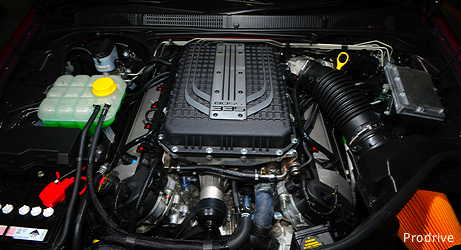Prodrive has developed a new supercharged 5.0-litre V8 engine for Ford's Australian Falcon GT models. The 'Miami' engine develops 455bhp (335kW) at 5750rpm and 570Nm from 2200 to 5500rpm.
“The old 5.4-litre ‘Boss’ unit used by Ford Performance Vehicles (FPV) was a tough act to follow but it had reached the limit of its emissions development and mechanical strength,” explains Bryan Mears, managing director of Prodrive’s Asia Pacific division. “It took three years and AUS$36million but the result is a new benchmark for a high-performance V8.”
The Miami replaces a naturally-aspirated 5.4-litre V8, saving 47kg yet providing more power. The supercharger also helps it to deliver more torque at lower engine speeds than its predecessor.
The new engine is also lighter, contributing to a more neutral front/rear weight distribution which improves handling.
The Miami engine is produced in two power ratings by altering the level of boost from the supercharger: a 422bhp/315kW model in the Falcon GS and a 455bhp/335kW version in the Falcon GT, GT-E and GT-P. These four high-performance vehicles are produced for the Australian market by Ford Performance Vehicles (FPV), a joint venture between Ford and Prodrive, and are the latest in a series of high performance versions of regular Ford models built by the company.
Global programme
FPV commissioned Prodrive’s global powertrain engineering team, headquartered at its Asia-Pacific technical centre in Melbourne, to develop the new engine.
“The challenge for the project team was to find an affordable way to produce a new, market-leading engine with the headroom to meet future emissions and performance targets,” says Mears. “It also had to satisfy the demanding new ‘One Ford’ global standards for engineering and durability.”
The Ford Mustang's Coyote V8 block and cylinder heads were the starting point. Using simulation techniques, Prodrive established the boost levels necessary to deliver the required power characteristics.
By optimising the supercharger installation, especially the drive ratio and intake runners, it was possible to reach the performance targets without an intercooler. This leaves untapped potential for future upgrades using higher boost levels with an intercooler, should these be required.
New parts include uprated exhaust valves, pistons, connecting rods, the complete intake and exhaust system, a high-capacity sump and oil cooling jets to control piston temperature. Even parts that are retained from the Mustang have been optimised for the new application, such as resetting the standard fuel injectors to suit the new combustion characteristics and rebalancing the crankshaft to suit the new pistons and rods.
Unlike a ‘bolt-on’ supercharger conversion, engineering changes are carried right through the engine to ensure long term reliability.
Rigorous development and validation processes included accelerated engine endurance tests, simulating 250,000km (155,000 miles) use in 14 weeks, and a vehicle durability programme of 170,000km (105,600 miles).
The programme used three levels of hardware: hand-made prototypes for early evaluation, pre-production samples for development and production parts for final validation.
Approximately 40% of the engine is manufactured locally and all engines are hand-built at FPV on the only V-8 assembly line in Australia. For the Falcon GS and GT models, volume is predicted to be around 1500 engines per annum.
“All over the world, vehicle manufacturers struggle to make niche model programmes financially viable in the face of substantial engineering costs,” says Mears. “The customer expects the same, or better, quality and durability from a limited-volume car as a mainstream model, yet the development overhead incurred must be recovered from a much smaller production run. We have produced an affordable, world-class engine to rigorous Ford standards through simulation for ‘right-first-time’ design and by the intelligent use of key existing parts. The Miami project has been so successful that there’s even the potential to sell finished engines back into the USA. That would be quite a compliment.”

